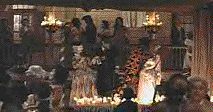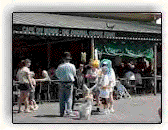Black Jade's Masquerade | home
Nightfall in New Orleans | Storylines | Black Jade | Rules | Approved Characters | Vampire the Masquerade | The Sabbat | The Clan Page | Werewolf the Apocalypse
Storylines
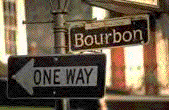
“These creators, makers of the new, can never become obsolete, for in the arts there is no correct answer ............ But the arts are another story ---- a story of infinite addition. We must find order in the random flexings of the imagination.” --- Daniel J. Boorstin, The Creators
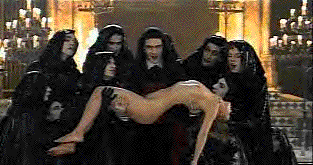
The heart of the immortal lurks somewhere within us all. The busy streets stand idly by as the deadly truth lurks in the shadows, stalking, waiting for the next hapless victim of illusion to step over their cracks. From the far reaches of all creation to the center of the soul, lies immortality. The life that we all shall find. The life of our deepest desires. Shall you walk these streets with obstinate feet, passing by all that is truth? Or shall your feet carry you find these desires? That what you wish shall be. Be careful of what you wish for. It's going to come true. Welcome to the Streets of New Orleans.
The the city that care forgot, The Big Easy, never sleeps. Or does it? It could depend on your view of consciousness. Seeping through the cracks of the sidewalks, behind the remodeled structures that designate the times of past, hides the shadows. Shadows of what once was and shadows of what is to come. No matter our views, the rumors carry. We hear tell of Gehenna, the Apocalypse, the end of life as we know it. Whatever term within our minds carries us to that conclusion is alive with more force then most care to realize. The Eternal Struggle lives within the heart of every being that walks the face of the earth. Rumors of the Jyhad float through Kindred society and the Wolves rage as the gnosis of the Wyrm follows sometimes too closely to home. Mortals hear modern prophets in the streets screaming their warnings of The End Times. Their television holds the images of all that they would have to be.
This timeless Struggle has been since the beginning and will be until there is an end. What that end might be may lie too closely to our own hands. In Kindred society, the modern children of the night fight within their own ranks. The Camarilla tries to keep control for the survival of the kindred while rumors of the Sabbat spread through the city as having taken over other cities in our Country. Even here the question is in all Kindred minds, are these rumors real? Does the dreaded Jyahd really exist? What is the real fear that lurks within the hearts and minds of mortal and immortal alike? Are we just afraid to listen?
The question still abides, is this within our own minds or do these ancient prophecies hold a grain of truth? Those who will see will see all too clearly. Pity those who deliberately close their eyes, for they cannot even see themselves. Pity those with fear, for the spirits speak to those who have the courage to listen. No other place in America gives those who choose it this much opportunity. Shall we forget the past? Leave history to it's own means? Those of New Orleans think not. Here the past and the future is very much alive behind each and every door. It is up to us to have the courage to open them.
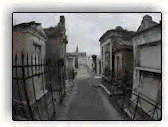
I. The Birth of a New Age: Many vampires familiar with The Book of Nod speak of an immine cataclysm, the end of one cycle and the beginning of another. The old order will be swept away, and many idealists and madmen among the Kindred increasingly espouse visions of the new order which will take its place. As the end of the millennium passes and talk turns to increasingly espouse visions of upheaval, the characters choose for themselves whether to resist the tides of revolution or be swept up in them. Will they fight to maintain the old order against anarchy, or will they join (or form) an idealistic crusade to reshape the world?
1.To Search for Hidden Secrets: Gehenna fast approaches, and many Kindred fear
that the world may soon go up in flames. The characters could be brood of a single
sire, or a coterie of individuals who must search out the millennia-old secrets of the
Antediluvians and identify their schemes before it’s too late.
II. The Free City: An ambitious council of primogen declare a city to be free and open to Kindred and kine alike, a place of peace where all can coexist. But can the dream work? The characters can be the agents working to build this daunting dream, making friends and allies out of former enemies. Then tragedy strikes ---- a misunderstanding (or outright sabotage) breaks the truce, and friend turns against friend.
2. Home Lies the Heart: The undead existence of a vampire is lonely and full of
horrors; it is no surprise, then, that many neonates try desperately to cling to the
relationships and normalcy of their mortal lives. Can vampires truly go home, or are
they simply stetting the stage for tragedy? For all that they prowl the night,
surrounded by unknowing kine, the fact remains that sunlit world is forever denied to
them, and the Hunger that they feel is a constant danger to their loved one.
Characters unwilling to leave their mortal lives behind must risk the Masquerade, their
Hunger, and the safety of those they care about. Are they selfishly clutching at the
warmth and affection that they may have taken for granted in life? Or are they
desperately trying to hold onto their humanity by focusing on the only things in life that
truly matter?
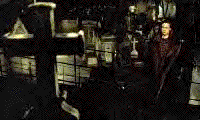
Links to ChatRoom-based Sites:
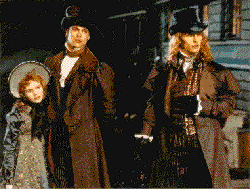

Descriptions of Public Chat Rooms:
French Quarter :
The heart of New Orleans. Wrought iron railings, French doors that remind you of 18th century France. High energy clubs, Cajun food. Is surrounded by the central business district (chat CBD) and waterfront. During the day it si shopping and local historic tours and at night is giant street-party and world class dining. Jackson Square is the heart of the French quarter, rich in history, was the center of executions and military exercises. In Jackson square is a church (St. Louis Cathedral) and a government building which is now a museum. Jackson square is the home of artists, musicians, dancers, magicians, and fortune tellers. Lined up next to Jackson Square is the Royal Carriage, a nice treat when traffic is bad, so line up and take a ride. Funky Pirate, located on Bourbon Street. Though live blues is as much a part of New Orleans as the humidity it can be tough to find in the Quarter. If the blues is the cure for what ails you then set sail for the Funky Pirate, which sports a full schedule of live and loud blues. Big Al Carson and the Heavyweight’s make up the closest thing to a house band. The décor is dedicated to the skull and crossbones faithful and manages to pull off a Caribbean pirates’ lair feel that stops a doubloon’s width of being tacky. While there are no Hurricanes in this territory there are plenty of other dangerous libations such as the Tropical Itch and the Great White Shark Attack. Three-for-one happy hour happens everyday and there are interesting dollar shot specials, such as the Pirate’s Passion, on and off throughout the night. Just look for the flashing sign over the stage. No cover but there is a one drink minimum.
Croissant d’Or :
One of the French Quarter’s best kept secrets, Croissant d’Or is the perfect hideaway to take a close friend and sneak off in the courtyard for hours while enjoying fine pastries. Enjoy a great cup of coffee or a frothy cappuccino. Fahy’s Irish Pub is the place where you can hang out with the locals, like you have been hanging out for years. The atmosphere is quiet enough to foster conversation and is located on the other side of Bourbon Street, so be a little more careful if you head to Fahy’s. The Old Absinthe House is also located on Bourbon Street, a veritable time-machine of a pub, open since 1807. A great place to eavesdrop on local gossip where chandeliers and an old pirate’s flag hang above the bar. Retired states flags line the wall and a fireplace gives it a timeless look.
Cafe du Monde :
A quaint restruant. Before the shops open in the quarter, a great time can be had at the open-air Cafe’ du Monde with the traditional coffee and donuts -- New Orleans style! The coffee is strong but the taste is great. Cafe’ au lait (pronounced Cafay-oh-lay) is a dark roast coffee and chicory with hot milk and it is a must when enjoying the hot French beignets (pronounced ben-yays) that have made the Cafe du Monde so famous.
The Original Cafe du Monde Coffee Stand was established in 1862 and has remained a traditional coffee shop ever since. Its menu consists of dark roasted Coffee and Chicory, Beignets, White and Chocolate Milk, and fresh squeezed Orange Juice. The coffee is served Black or Au Lait, which means that it is mixed half and half with hot milk. In 1988 both soft drinks and Iced Coffee were introduced to the Café.
According to Café officials, the taste for coffee and chicory was developed by the French during their civil war. Coffee was scarce during those times, and they found that chicory added body and flavor to the brew. The Acadians from Nova Scotia brought this taste and many other French customs to Louisiana. Chicory is the root of the endive plant, which is a type of lettuce. The root of the plant is roasted and ground and is added to the dark roasted coffee to soften its bitter edge. It adds an almost chocolate flavor to the Cafe Au Lait served at Cafe Du Monde. Beignets (pronounced ben-yay) were also brought to Louisiana by the Acadians. These were fried fritters, sometimes filled with fruit. Today, the beignet is a square piece of dough, fried and covered with powdered sugar. They are served in orders of three for a dollar and change.
Without a doubt, this open-air café is an excellent location to sit back and watch the hundreds of people strolling by, as it is located at the edge of bustling Jackson Square. There are always plenty of street performers in the area as well, providing fantastic and free entertainment throughout the entire day. Although the Café is almost always filled with customers, the experience is well worth fighting the crowd. If you want to avoid the crowd, get there very early in the morning or during the wee hours of the night; it is open 24 hours! The Cafe closes only on Christmas Day and on the day an occasional Hurricane passes too close to New Orleans.
Oz :
Enter Oz and there is no mistaking you are nowhere near Kansas anymore, Dorothy. I mean nowhere. With multiple floors ( the entry level dance floor is cavernous), absolutely booming music and frenetic lighting this is the dance mecca of Bourbon Street. The crowd, and the music, and the lights often spill out into the street. If you need a break from the break neck bump and grind there is a quieter sit down and socialize bar upstairs that opens onto a large wraparound balcony. The balcony offers an excellent view of Bourbon. Oz stays crowded late and the energy level never dips. There is a cover that fluctuates and is higher than most places on Bourbon, so check that out before you get in line. Oz is gay friendly but hardly gay exclusive. The man behind the curtain is all about the boogie, baby. A must for dance club aficionados.
The Cat’s Meow :
The Cat’s Meow is a world famous club and was the first to install karaoke, located on Bourbon Street.
Ye Old Original Dungeon:
Ye Old Original Dungeon is the place to feed your inner vampire. You'll have to wait until the witching hour to get in, but this dark French Quarter hideout is the place to go to feed your inner vampire. It doesn't matter if you love Marilyn Manson or not, this bar attracts anyone in need of a good time. The crowded, upstairs dance floor beats continuously with rockin' music while the long downstairs bar offers seating and jukebox music of all kinds, located on Toulouse Street.
Faborg Maringy :
“The City of right angles and tough, damaged people.” --- Pete Hammill
Considered the first suburb of New Orleans, founded on the plantation of Benard de Maringy, who divided his property into lots. Called “the maze of New Orleans.” Comprised of angular streets of triangles, pentagons and squares all at 45 degree angles. 1810 dates back to the earliest year of building contract can be found for the Maringy. One of the Gay and Lesbian neighborhoods, where the wild run through the streets at night.
After 1805, New Orleans residents felt a need to expand the boundaries of the city and many settled in the Faubourg Marigny, considered the first suburb of New Orleans. This new area included the plantation of Bernard de Marigny who inherited this property in 1800 from his father, Pierre Phillipe de Marigny de Mandeville. In 1808, this twenty-year-old petitioned the city to subdivide his property closest to the city into lots. This section of New Orleans, known as the Marigny, currently runs from Esplanade Avenue to Franklin Avenue.
The Faubourg Marigny, the maze of New Orleans, comprises of angular streets that form triangles, pentagons, and squares set at 45 degree angles. Numbers jump their sequence mid-block and so do street names. For example, Bourbon becomes Pauger in the middle of the block.
Creole cottages abound this area and so do buildings dating back from this influx into this section. 1810 dates back to the earliest year that a building contract can be found for the Marigny. Spanish, French, Free People of Color, Italians, Germans, and Irish were among the first ethnic inhabitants to live in this section of the city.
Many Free Women of Color owned property in the Marigny. Many of these women were involved in relationships with white men, known as placage.
Eugenie Glesseau's life and relationship with Jean Baptiste Azerto indicates the pervasiveness of these relationships in New Orleans. In 1844, Glesseau received a cottage as a gift from Francisco Cheti located at 1308 Esplanade. In the title Cheti states, "not to alienate the property until the youngest of the children which she had with Jean Baptiste Azereto during their co-habitation attains twenty-one years...or the donation will be null and void." The couple never married although Azereto recognized their offspring as his own.
The Marigny has seen a rejuvenation in activity in recent years. Neighborhood bars dot the streets in regular intervals. Tattoo parlors, jazz clubs, and various cafes and restaurants make their mark in this section, also. The beauty of this section lies in its proximity to the French Quarter but without the tourist activity that the Quarter offers. Walking through the Marigny, a person can feel one with the history and the beauty of this area. The latter is alive everywhere.
WareHouse District :
Where young professionals and old artists mingle in a varied array of bars and clubs.
Many of the art galleries in New Orleans are located in the Warehouse District which is between the Central Business District and the Lower Garden District, all the way uptown along Magazine Street. On the first Saturday of each month these galleries open their doors in the evening for twilight exhibitions.
CBD :
Central Business District
Garden District :
History, giant oaks, eaves old antebellum mansions.
Across Canal Street going away from the Quarter and further down from today's Central Business District, the Garden District has emerged one of the premier neighborhoods in the country. This section of the city possesses some of the finest architecture in New Orleans. Greek Revival Mansions and townhouses enhance the oak-lined streets. Although the district doesn't have the hustle and bustle of the French Quarter, it is another section of the city that definitely has a European flare of its own. The Lower Garden District is composed of four different sections: the Irish Channel with its industrial buildings and warehouses, Annunciation Square with its Greek Revival architecture, Coliseum Place which became popular for residents during the 1840s and 1850s, and New Basin Canal which had a high concentration of Irish immigrants who flocked to New Orleans during the mid-nineteenth century. Until recently, this section of New Orleans had deteriorated to squalid-like conditions. Today however, this area has seen a greater revival than any other part of New Orleans. Bed and Breakfasts, vintage clothing boutiques, and antique stores along with restaurants and coffeehouses line Magazine Street. A few galleries pop up here and there, too.
the Fly :
Visit the Fly and laze in the sunshine beside the rolling Mississippi.
City Park :
In the Middle of New Orleans is the 5th largest urban par in the country. More than 100 acres in size, City Park became a park in 1854. It is home to 250 historic oak trees which seem define the natural beauty of New Orleans. Many of the Oaks are older than the park's inception. The trees have a great history in the formation of New Orleans, as many a duel had been fought here beneath the mammoth branches on early foggy mornings. In City Park there are 'flying horses' -- one of just a mere 100 carousels left in operation in the nation. This is the only operating carousel in Louisiana. There are other rides in the park for children, including a Ferris wheel, a roller coaster, bumper cars, and two miniature trains. In the 'Storyland' section, a child can enjoy Peter Pan’s Pirate Ship, follow Gepetto into the mouth of the whale or climb Miss Muffet’s Spider Web Rope Climb. There are many puppet show performances for the young and young-at-heart as well. The park offers many areas for picnics or play. Several bayous are found in the park acreage. The four Bayou Oaks Golf Courses are the largest municipal golf facility in the South. 'Golf Digest' named the courses at the place to play in the New Orleans area. Bayou Oaks features four 18 hole golf courses. Carts and club rentals are available at the fully-stocked pro shop. The park also has Tad Gormely Stadium which contains a football and soccer field. The Track Field was brought up to standards for pre-Olympic trials in the late 1990’s.
City Park & Faubourg St. John
As many people already know, New Orleans at its lowest point stands about eight feet under sea level. Draining the city's outlying swamps stumped city planners for nearly two hundred years and many areas, now a part of incorporated New Orleans, did not develop until the turn of the twentieth century. The City Park and Faubourg St. John section of New Orleans was no stranger to this problem, with the exception of Bayou Road, a well settled thoroughfare dating back to the colonial era.
Esplanade Avenue begins at the Mississippi River and divides the French Quarter from the Faubourg Marigny. This boulevard ends at City Park where the New Orleans Museum of Art is located. Local philanthropist, John McDonough, owned the plantation where the park is currently located. When he died in the mid-nineteenth century, he deeded this property to New Orleans who decided to make it into a park.
When settlers first came to Louisiana, they met with local American Indians to barter and to trade in this area. They also set their post here during the building of the Vieux Carre.
Creole plantations can still be found, including the Pitot House built in 1727. Also among the more notable homes in this area is the Degas House where famed artist Edgard Degas lived for a short time.
During the Spring, this area becomes extremely popular for one of the city's major festivals: the Jazz and Heritage Festival. People from all over the world come to this section of New Orleans for two weeks to find themselves dancing, eating, and drinking at the Fairgrounds.
While this is mostly a residential area, a few boutiques and restaurants are scattered throughout. It is best to visit this area when Jazz Fest is not taking place so that the charm of the old Victorian homes and the stunning beauty of City Park can stand out on their own.
Fairmont Hotel, Imperial Ballroom :
Where Black Jade holds some of her shows.
Location:
123 Baronne St.
New Orleans
Rings of Desire:
1128 Decatur St, French Quarter. Phone: 524-6147
Rings of Desire is the most oft-praised and recommended piercing studio in the New Orleans area. You can choose several different price levels of piercers, from Novice to Master, to suit your price range. The facilities are very clean, the staff are personable and knowledgeable, and lastly - you must see the air-conditioning system. It's shaped like a giant spider.
ESOTERICA :
541 Dumaine St, French Quarter. Phone: 581-7711
Esoterica is a fairly non-touristy occult supply store with a reasonably friendly staff. Candles, incense, tarot decks, and all your occult needs. They do readings and stock steel-boned corsets from Vollers, too.
MARIE LAVEAU'S HOUSE OF VOODOO :
739 Bourbon St, French Quarter. Phone: 581-3751
This place is touristy as hell, and you'll have to brave Bourbon Street, but the House of Voodoo is the best place in the city to find cheap rosaries. They also have spooky masks, tarot cards, voodoo items in general, and many skull-themed things. The House of Voodoo also does tarot readings, in case you're into that kind of thing.
Gargoyles :
1205 Decatur St, French Quarter. Phone: 529-8437
New Orleans' largest independent gothic/industrial/fetish/club clothing store, with a pretty wide selection of styles and an increasingly wide range of prices as well. Gargoyles stocks quite a bit of leather & other fetishwear in the second room, while the front room caters more to the fashion- rather than fetish-oriented. Brands carried include Lip Service, Funhouse, Cykxtees, Archaic Smile and more. Good selection of both mens and womens clothing - from club to glam to glitter to traditional goth to industrial to fetish to swirly...well, you get the point. Gargoyles also carries accessories such as belts, stickers, studs, spikes, hair dye, etc. Extremely friendly staff and good service, as well as a fully-functioning online version of the store for you hermits out there.
All shown in red with asterisks have been declared Elysium by the Prince.
